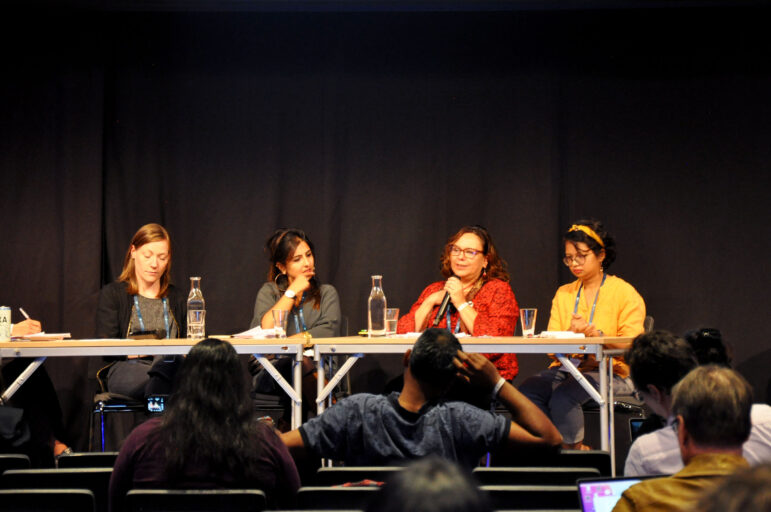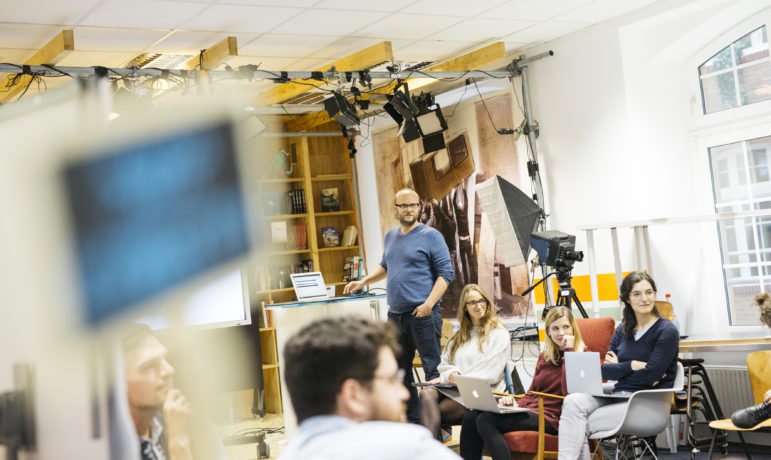

Marcela Turati (second from right), co-founder of Mexico-based Quinto Elemento Lab, speaking at GIJC23 alongside moderator Rozina Breen and co-panelists Priyanka Raval and Aidila Razak (left to right). Image: Wiktoria Gruca for GIJN
Crowd-Driven Journalism: Four Groundbreaking Investigative Projects Powered by Public Engagement
Communities are often considered as merely our audience in journalism. However, the journalist-community relationship can go far beyond this top-down approach. Local communities can be engaged to help report impactful stories, provide tips and resources, and even bolster the finances of watchdog media around the world.
Citizens can serve not only as a valuable resource but as a driving, collaborative force behind investigations. Some of the best investigative projects wouldn’t even exist without the support from local communities. At the 13th Global Investigative Journalism Conference (#GIJC23), four outstanding examples of how journalism can benefit from communities were presented during the panel “Crowd-Driven Journalism: Using Communities to Investigate,” moderated by Rozina Breen, CEO and editor-in-chief of The Bureau of Investigative Journalism (TBIJ).
“By creating strategic alliances we can unite forces and capabilities to have more impact and reach different audiences,” explained panelist Marcela Turati, the co-founder of Quinto Elemento Lab, an independent nonprofit that supports investigative journalism in Mexico. Priyanka Raval, a journalist from the UK investigative newsroom The Bristol Cable, even attributed her group’s success to “community involvement,” calling it the driving force behind the newsroom when the local media scene was in crisis.
Aidila Razak, special reports editor from Malaysiakini, added that communities can be sources of information, but also an important democratic institution for fighting corruption or protecting democratic values. But Julia Hildebrand of Correctiv, which created the CrowdNewsroom project, said outreach is only the first step. It is not enough to talk to people and ask for feedback, but it’s about “building the organization together.”
To further understand the impacts and possibilities of community-driven investigative journalism, here are some more insights into the four innovative projects presented by the speakers.
Quinto Elemento Lab, Mexico
Quinto Elemento Lab was launched in 2017 with the goal not only to conduct investigative reporting, but to empower citizens, strengthen accountability, and help build a more transparent society. Since then, it has published award-winning investigations about human rights, gang violence, and corruption.
The small team has a unique approach to community-driven journalism. By building teams consisting of their own reporters and local reporters in the area they want to shed light on, they can not only provide editorial support and consultation for journalists, but also share resources with reporters who might not have access to the same structures or funding. Marcela Turuti calls these teams “strategic alliances to unite forces and capabilities to have more impact and reach different audiences.”
One example of this she presented at the conference is the podcast project Periodismo de lo posible (“Journalism of What’s Possible”), a 12-part historical series about resistance to environmental exploitation around Mexico, reported by journalists from those communities. The project was established with support from Quinto Elemento reporters, and afterwards presented in the assembly of the local community — where the members themselves could vote on what would be published and what not. “This way, they return the story to the community that it derives from,” Turati explained. A special feature: All of their teams strive for gender equality and have at least one woman on board — to counteract the machísmo often found throughout Mexican society, she said.
Malaysiakini, Malaysia
Malaysiakini has become the most influential crowd-driven journalism project in Malaysia. Founded in 1999, for a long time it was the only media outlet in the country that had a subscription model. “No one else was able to be that independent,” Razak noted. But being funded by their readers creates a special accountability for them towards their audience, she added.
This funding model, she said, drives a high level of engagement in the site’s comments section, which the reporters not only notice, but benefit from. By acknowledging the readers’ opinions and interests, Malaysiakini can actually adapt to what topics the community would like to be investigated. This becomes an important tool to hold the ones in power accountable
Razak also shared a story that probably serves as the best metaphor about how important the community is for the newsroom: During a crowdfunding campaign for a new building, readers could buy a brick with their name on it. In the end, they raised enough money to build the new headquarters — and some of the bricks are now embedded in their offices.
The Bristol Cable, United Kingdom
In 2014, the UK journalism industry was at “rock bottom,” Priyanka Raval recalls. That’s when a small group of volunteers decided to build an alternative to the corporate-owned local media in Bristol, a West England city of around 700,000. They started a crowdfunding campaign and built a local, investigative, independent newspaper from scratch, which remains completely funded by the public.
This membership model has allowed the reporters to focus on long-term investigations, some of which have won notable awards. A special focus of the newsroom is engaging readers in the editorial process. For example, prior to a recent election, the newsroom asked their readers which issues mattered most to their community, compiled a list, and approached the candidates with the exact topics that the locals wanted them to be confronted with.
“This really makes a difference,” Raval said, because they can focus on issues that are actually important to their community — and then hold politicians accountable. When Google offered large-scale funding for journalism projects around the globe, The Bristol Cable asked their readers if they should take it. The community said no — so the newsroom didn’t. “They are the reason we exist,” Raval said, “so they can hold us to account.”











